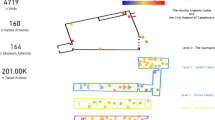Abstract
Integrating and analyzing a large amount of data extracted from different sources can be considered a key asset for businesses, organizations, research institutions that also deal with the Cultural Heritage domain. In the last decade, Internet of Things (IoT) technologies and the massive use of mobile devices contributed to generate an enormous flow of multimedia data, whose collection, analysis and interpretation allows for real-time analysis related to the behaviours, preferences and opinions of users. In this paper we present and discuss an unsupervised learning approach on multimedia features of a dataset coming from an Internet of Things framework. The main research objective of this work is to assess how the collection of behavioural IoT data coming from the Cultural Heritage domain can be opportunely exploited by means of unsupervised learning techniques in order to produce useful insights for the stakeholders, especially considering the multimedia features of such data. The presented experimental results, executed in a real case study, assess how the Cultural Heritage domain, and the related stakeholders, can benefit from these kind of services and applications.








Similar content being viewed by others
References
Aria M, Cuccurullo C (2017) Bibliometrix: an r-tool for comprehensive science mapping analysis. J Inform 11(4):959–975. https://doi.org/10.1016/j.joi.2017.08.007
Bollo A (2016) Il monitoraggio e la valutazione dei pubblici dei musei. gli osservatori dei musei nell’esperienza internazionale. Quaderni della Valorizzazione – Nuova Serie, 2, Direzione Generale Valorizzazione-Mibact
Ibba A, Duin R, Lee WJ (2010) A study on combining sets of differently measured dissimilarities. pp 3360–3363. https://doi.org/10.1109/ICPR.2010.820
Jung YJ, Zimmerman HT, Pérez-Edgar K (2018) A methodological case study with mobile eye-tracking of child interaction in a science museum. TechTrends 62(5):509–517. https://doi.org/10.1007/s11528-018-0310-9
Katifori A, Karvounis M, Kourtis V, Perry S, Roussou M, Ioanidis Y (2018) Applying interactive storytelling in cultural heritage: opportunities, challenges and lessons learned. In: Rouse R, Koenitz H, Haahr M (eds) Interactive storytelling. Springer International Publishing, Cham, pp 603–612
Kaufman L, Rousseeuw PJ (1987) Clustering by means of medoids
Krause A, Siewiorek DP, Smailagic A, Farringdon J (2003) Unsupervised, dynamic identification of physiological and activity context in wearable computing. In: Proceedings of the 7th IEEE international symposium on wearable computers (ISWC’03). IEEE Computer Society, Washington, p 88
Maechler M, Rousseeuw P, Struyf A, Hubert M, Hornik K (2019) Cluster: cluster analysis basics and extensions. R package version 2.1.0 — for new features, see the ‘Changelog’ file (in the package source)
Martella C, Miraglia A, Frost J, Cattani M, van Steen M (2017) Visualizing, clustering, and predicting the behavior of museum visitors. Pervasive Mobile Comput 38:430–443. https://doi.org/10.1016/j.pmcj.2016.08.011
Ohlei A, Bouck-Standen D, Winkler T, Herczeg M (2018) Infogrid: acceptance and usability of augmented reality for mobiles in real museum contexts. In: Dachselt R, Weber G (eds) Mensch und computer 2018 - workshopband. Gesellschaft für Informatik e.V., Bonn
Pekalska E, Duin R (2001) On combining dissimilarity representations. Multiple Classifier Systems: 359–368
Piccialli F, Yoshimura Y, Benedusi P, Ratti C, Cuomo S (2019) Lessons learned from longitudinal modeling of mobile-equipped visitors in a complex museum. Neural Comput Appl: 1–17
Pierdicca R, Marques-Pita M, Paolanti M, Malinverni ES (2019) Iot and engagement in the ubiquitous museum. Sensors 19(6):1387. https://doi.org/10.3390/s19061387. https://www.mdpi.com/1424-8220/19/6/1387
Portalés C, Rodrigues JMF, Rodrigues Gonçalves A, Alba E, Sebastián J (2018) Digital cultural heritage. Multimodal Technologies and Interaction 2(3), https://doi.org/10.3390/mti2030058. https://www.mdpi.com/2414-4088/2/3/58
Reynolds AP, Richards G, de la Iglesia B, Rayward-Smith VJ (2006) Clustering rules: a comparison of partitioning and hierarchical clustering algorithms. J Math Modelling Algorithms 5(4):475–504. https://doi.org/10.1007/s10852-005-9022-1
Roussou M, Katifori A (2018) Flow, staging, wayfinding, personalization: evaluating user experience with mobile museum narratives. Multimodal Technologies and Interaction 2(2):32. https://doi.org/10.3390/mti2020032
Traboulsi C, Frau M, Cabiddu F (2018) Active seniors perceived value within digital museum transformation. The TQM Journal 30 (5):530–553. https://doi.org/10.1108/tqm-11-2017-0155
MA W (1935) Problems of installation in museums of art. American Association of Museums 14:29–30
Won H, Yu J (2018) Interactive media art based on location and motion tracking of multi-performers. In: Ioannides M, Fink E, Brumana R, Patias P, Doulamis A, Martins J, Wallace M (eds) Digital heritage. Progress in cultural heritage: documentation, preservation, and protection. Springer International Publishing, Cham, pp 111–117
Zancanaro M, Kuflik T, Boger Z, Goren-Bar D, Goldwasser D (2007) Analyzing museum visitors’ behavior patterns. In: Conati C, McCoy K, Paliouras G (eds) User modeling 2007. Springer Berlin Heidelberg, Berlin, pp 238–246
Acknowledgements
This work was supported by the OPS-REMIAM project [Grant Number PON03PE_00161] and the Cultural Equipment with Transmedial Recommendation Analytics - C.E.T.R.A. project [Regione Campania - Bando RIS3 2018 - Fase 2 - Supporto di progetti, anche collaborativi, di sviluppo precompetitivo, trasferimento tecnologico da parte delle MPMI campane]
Author information
Authors and Affiliations
Corresponding author
Ethics declarations
Conflict of interests
The authors declare that they have no conflict of interest.
Additional information
Publisher’s note
Springer Nature remains neutral with regard to jurisdictional claims in published maps and institutional affiliations.
Rights and permissions
About this article
Cite this article
Piccialli, F., Casolla, G., Cuomo, S. et al. Unsupervised learning on multimedia data: a Cultural Heritage case study. Multimed Tools Appl 79, 34429–34442 (2020). https://doi.org/10.1007/s11042-020-08781-1
Received:
Revised:
Accepted:
Published:
Issue Date:
DOI: https://doi.org/10.1007/s11042-020-08781-1




